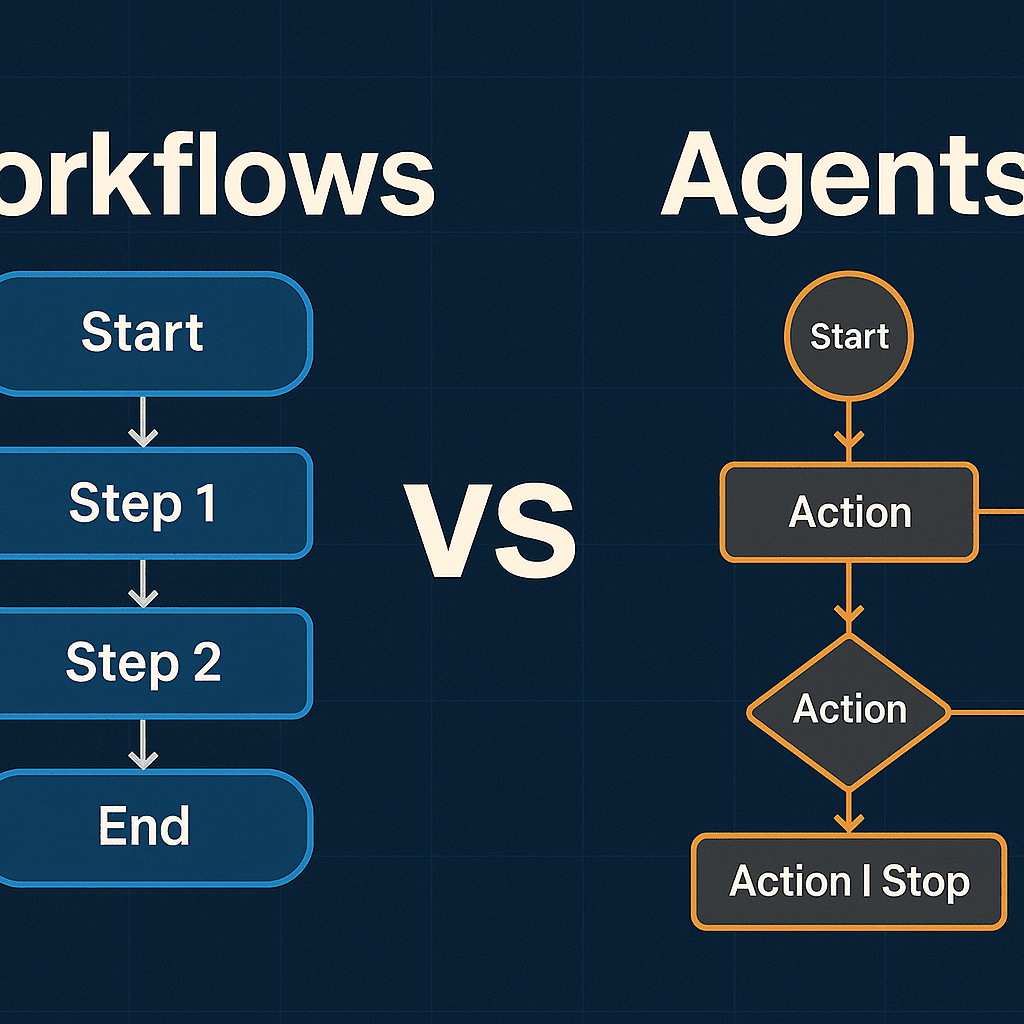Are you building with autonomous agents just because they sound cool? Or does your use case truly demand it? Let’s unpack the reality behind the hype.
In the rush to build smarter AI systems, one big decision often gets overlooked: Workflows vs Agents. If you’ve ever found yourself excitedly launching agents to handle everything — only to watch them spin in infinite loops, drain your tokens, and return questionable outputs — you’re not alone.
The truth is, not every AI task needs autonomy. In fact, in most production settings, you probably need structure more than spontaneity. So, let’s dive into this discussion like real builders and break it down — without the buzzwords and overhype.
Table of Contents
- What Are Workflows and Agents in AI?
- Why Everyone’s Talking About Agents (Even If They Shouldn’t Be)
- Workflows: The Reliable Friend
- Agents: The Creative Genius with a Wild Side
- Real-World Use Cases: When Each One Works Best
- Cost, Control, and Chaos: The Trade-Offs
- Choosing the Right Path for Your AI Project
- Final Thoughts
What Are Workflows and Agents in AI?
Let’s define our terms clearly.
- Workflow: A sequence of predefined steps that use AI tools in a specific order. You control every action — like a recipe.
- Agent: An AI system that decides what steps to take, when to take them, and even which tools to use — often in a loop until it reaches its goal.
Think of a workflow as a GPS. It gives you turn-by-turn directions.
An agent? More like handing someone a map, a phone, and a credit card and saying, “Figure it out.”
Why Everyone’s Talking About Agents (Even If They Shouldn’t Be)
Agents are exciting — we get it. They sound like magic. You give them a goal, and they get to work, thinking, choosing tools, adapting. This flexibility makes headlines. “AI Agent Handles 700 Customer Tickets Daily” sounds cooler than “Pipeline Solves 89% of Requests Consistently.”
But for most developers, the question isn’t “Can I use agents?”
It’s: “Should I?”
Workflows: The Reliable Friend
Workflows are like that one friend who always shows up on time, sticks to the plan, and follows the checklist.
Why do engineers love them?
✅ Predictable and testable
✅ Easy to debug with logs
✅ Cheaper — fewer tokens, fewer retries
✅ Production-ready with less drama
Example: A customer sends a support message. Your workflow classifies it (billing, tech, general), retrieves context, calls the LLM to generate a response, and logs the answer. Simple. Efficient. No surprises.
Agents: The Creative Genius with a Wild Side
Agents are brilliant — but unpredictable. They loop. They reason. They may even hallucinate steps if your prompt isn’t crystal clear.
They work best when the flow isn’t obvious.
Say, a customer message needs:
- Clarification
- Knowledge base search
- Billing info
- A decision on whether to escalate
A well-prompted agent can dynamically decide all of that. But it can also burn 10x the tokens doing so.
Real-World Use Cases: When Each One Works Best
Workflows are ideal when:
- The task has a clear structure
- You need cost-efficiency
- You need repeatable outcomes
- You have production deadlines
Agents make sense when:
- The task is open-ended or ambiguous
- Conversations are multi-step and dynamic
- You’re dealing with high-value, low-volume problems
- Exploration or decision-making is core
Example: BCG used a multi-agent design system to cut 45% of shipbuilding time. Worth it — because each decision saved millions.
Cost, Control, and Chaos: The Trade-Offs
Let’s be honest — the costs of agents aren’t just financial.
💸 Token Usage
- Workflows: Straightforward prompt + output
- Agents: Reasoning loops = 4x to 15x token use
🧩 Debugging
- Workflow: Code traces
- Agent: Prompt archaeology
🔐 Security
- Workflow: Hard to break
- Agent: New attack vectors — memory poisoning, jailbreaks, injection
🔄 Maintenance
- Workflow: One dev can handle it
- Agent: You’ll need infra (LangFuse, AgentOps, token guards, etc.)
Choosing the Right Path for Your AI Project
Here’s a quick checklist to help you decide.
| Question | If YES, Use Agent | If NO, Use Workflow |
|---|---|---|
| Is the task ambiguous or multi-step? | ✅ | ❌ |
| Is there high variance in user input? | ✅ | ❌ |
| Is cost a big concern? | ❌ | ✅ |
| Do you need strict control over outputs? | ❌ | ✅ |
| Will this go to production soon? | ❌ (unless you have infra) | ✅ |
Remember, just because you can use an agent doesn’t mean you should.
Final Thoughts
Workflows vs Agents isn’t a binary battle. It’s a decision about what your problem needs right now — control or autonomy.
If you need reliability, transparency, and simplicity? Start with a workflow.
If you need flexibility, dynamic reasoning, and adaptability? Agents might be worth the effort.
The smartest builders don’t chase trends. They choose the right tool for the job. So next time you’re tempted to spin up a multi-agent system, ask yourself:
“Is this task a GPS trip… or a cross-country adventure?”

